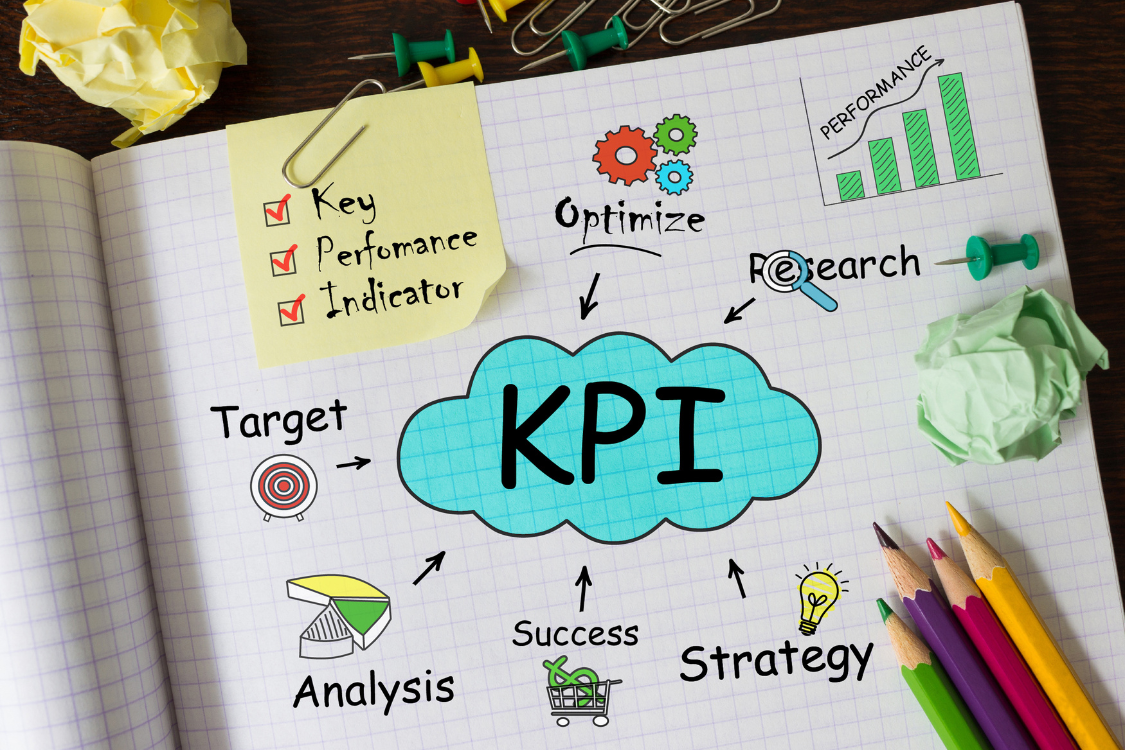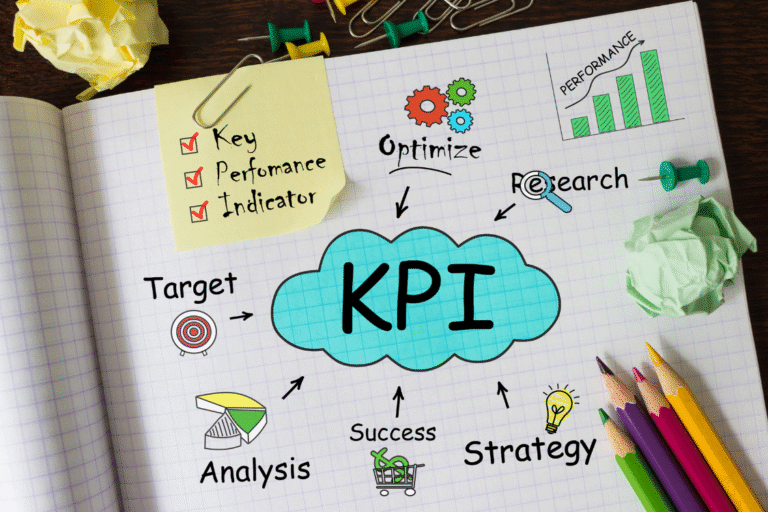Small-business sales often stall because owners lose focus or skip consistent progress checks. Without clear KPIs for selling a business, deals can drag, brokers lose momentum, and pricing adjustments arrive too late. Using seller-focused key performance indicators (KPIs) replaces guesswork with measurable direction.
These KPIs are not generic sales metrics. They track how your sale moves from listing to qualified leads to written offers. When you focus on three core indicators—Listing Date, Qualified Leads, and Offers Received—you can see where to act each week.
Track weekly, adjust fast, and keep your sales on pace.
TL;DR Summary
- Sales can slow when there is no consistent cadence.
- Three Key Performance Indicators (KPIs), Listing Date, Qualified Leads, and Offers Received, help keep the sale on track.
- Review weekly to address gaps and maintain momentum.
KPI At-a-Glance
| KPI | Target | Action if Off-Track |
|---|---|---|
| Listing Date | Go-live on all major channels | Audit broker and syndication for delays |
| Qualified Leads | 3–5 verified per week | Expand channels, improve teaser and sales funnel assets |
| Offers Received | 1 or more per active month | Rework price narrative, add factual support, strengthen outreach |
Understanding Business Sale KPIs
Understanding key performance indicators (KPIs) is essential because they turn the selling process into a measurable roadmap. The right KPIs to track give buyers confidence and help you manage the sale with clarity, not assumptions.
Regular measurement also makes performance easier to evaluate and your deal easier to defend during negotiation.
What Is a KPI and Why Does It Matter During a Sale
A Key Performance Indicator (KPI) measures how well you are progressing toward a specific goal during your sale. According to Eric T. Peterson, author of The Big Book of Key Performance Indicators (2006), KPIs are defined by their context—they are typically rates, ratios, averages, or percentages, not just raw numbers. This transformation from “10,000 is just a number” into a meaningful rate is what makes a KPI an actionable insight that provides real business value.
Each KPI should also follow the SMART framework: Specific, Measurable, Achievable, Relevant, and Time-bound. In the context of selling a business, that might mean tracking metrics such as “four qualified leads per week” or “one offer received within 30 days.”
KPIs matter because they demonstrate consistency and preparation—two qualities that buyers value when evaluating a company. They document key milestones, such as the date your listing went live, the number of verified leads, and the volume of offers. Tracking these indicators regularly helps you measure progress, show momentum, and justify your pricing decisions with clear, data-based evidence.
Difference Between Metrics and KPIs
The difference between metrics and KPIs is that metrics measure activity, while KPIs measure outcomes tied to goals.
For example, an “email open rate” is a metric. It shows engagement but not results. “Offers Received” is a KPI because it reflects progress toward a sale.
| Metric (Activity) | KPI (Goal-Aligned Outcome) |
|---|---|
| Listing Views | Qualified Leads |
| Calls Made | Offers Received |
| Email Opens | Inquiry-to-Offer Conversion |
| Broker Updates | Days to First Qualified Lead |
Tracking KPIs helps sales leaders, sales managers, and business owners focus on numbers that move deals forward, rather than relying on vanity data.
How KPIs Prevent Last-Minute Surprises
Tracking KPIs on a weekly basis helps identify slowdowns before they become major problems. For example, if you have no qualified leads for two consecutive weeks, it may signal the need to expand channels or adjust your teaser copy. Leading indicators, such as listing views and inquiries, reveal early momentum, while lagging indicators, including offers received, closing rate, and average deal value, confirm final outcomes. Reviewing both gives you a full picture of what’s working and what’s not.
Maintaining this rhythm also supports Operating Cash Flow (OCF) planning. If marketing expenses continue but offers decline, you can make a decision sooner about whether to reallocate resources. Keeping weekly KPI snapshots in your data room builds transparency, demonstrates broker accountability, and reassures potential buyers that your sale is being managed with structure and foresight.

KPI #1 – Listing Date
The Listing Date is your official launch point. It marks when your business becomes visible to buyers and starts generating measurable activity. This date helps you compare progress week over week and hold your broker accountable for outreach and exposure.
What Qualifies as Your Listing Date
Your Listing Date is the first confirmed day your business goes live across all public channels—such as BizBuySell, your broker’s website, and relevant industry listings. It’s the baseline for all your future KPIs, so confirm it carefully and verify that your listing is visible in search results.
Syndication Coverage Checklist:
- Platforms live on BizBuySell, LoopNet, FranchiseGator, and a broker site
- Correct category, region, and tags applied
- Clear images and accurate teaser copy uploaded
- Broker confirmation with date and timestamp
- Listing visibility verified within 24 hours
Why a Clear Go-Live Date Builds Urgency
A clear go-live date establishes urgency and accountability. It helps you coordinate launch-week follow-ups, measure visibility, and assess broker performance. The first week often brings the highest level of buyer attention, making timing and clarity essential.
Track these micro-KPIs to gauge progress:
- Time to First Qualified Lead: The number of days from go-live to your first verified inquiry.
- Listing View-to-Inquiry Rate: The percentage of views that turn into direct inquiries.
Compare these results against similar listings to set realistic expectations and fine-tune your sales strategies early.
Steps to Take if Your Listing Is Delayed
If your listing doesn’t go live on schedule, act quickly to maintain momentum. A delay can limit visibility and affect early sales revenue potential. Follow this short escalation plan to stay proactive:
- Broker Check: Confirm submission and publishing times. Verify your broker has met syndication deadlines.
- Syndication QA: Double-check category accuracy, pricing, image quality, and search visibility across every platform.
- Fallback Options: If needed, post a teaser on your website, email list, or LinkedIn to maintain activity in your sales pipeline.
Quick Copy Checklist:
Create a strong, fact-based listing with a clear headline, bullet points, and concise proof of profitability such as Gross Margin and Net Profit Margin. Include light references to Customer Acquisition Cost (CAC) and Customer Lifetime Value (CLV) where relevant, along with credible customer satisfaction or customer loyalty details.
Sample Launch Blurb (60 words):
“Now listed: an established [industry] business with a solid track record and verified financials. Ideal for buyers seeking clear operational data and steady sales revenue. Request a detailed information pack to review margins, recent sales growth, and key operational metrics.”
Image Alt-Text Checklist:
- Business exterior or logo
- Core products or services
- Daily operations or workspace
- Staff or management photo (if applicable)
- Simple performance or financial chart
- Regional service map

KPI #2 – Qualified Leads
Qualified Leads show how well your marketing and outreach are connecting with serious buyers. Tracking this KPI helps you focus resources on the highest-quality prospects and identify which channels bring the best engagement.
How to Define a Qualified Lead
A qualified lead is a potential buyer who meets specific requirements. They’ve signed a Non-Disclosure Agreement (NDA), provided proof of funds, have relevant experience, and fit your transaction timeline. Tracking your Lead-to-Customer Conversion Rate (Win Rate) reveals how many verified leads convert into offers. Segmenting by source helps identify which marketing channel generates higher average deal values and stronger sales performance.
Vetting Buyers Effectively
Vetting buyers thoroughly saves time and keeps the sale on schedule. Use a structured process to filter for genuine interest:
- Verify proof of funds within 48 hours of receiving the NDA.
- Confirm professional background and fit before sharing confidential data.
- Flag red signals like incomplete details, delayed responses, or vague intent.
You can also monitor Median Hours to Vet a Lead and Percent Passing Vetting as micro-KPIs. A consistent vetting process improves sales team performance and demonstrates professionalism to qualified buyers.
Tools and Templates for Tracking Leads
Tracking leads efficiently ensures nothing slips through the cracks. A basic spreadsheet can include:
- Date received
- Source of inquiry
- NDA signed (Yes/No)
- Funds verified (Yes/No)
- Industry relevance
- Notes and next steps
For a more advanced approach, use a CRM to track Sales Cycle Length, Sales Pipeline Velocity, and Sales Velocity, calculated as:
(Opportunities × Average Deal Value × Win Rate) ÷ Sales Cycle Length.
Attach a short Lead Vetting Script to maintain consistency across your sales reps or assistants. Link this data with sales target attainment, customer relationships, and overall sales team performance to help your sales manager coach follow-ups effectively.

KPI #3 – Offers Received
Offers Received is one of the most important KPIs for selling a business, because it shows how well your listing and outreach efforts are converting real buyer interest into written proposals. While inquiries reflect curiosity, written offers confirm market engagement and pricing alignment.
Why Written Offers Matter More Than Interest
Written offers and Letters of Intent (LOIs) are the clearest sign of genuine buyer commitment. Track your Inquiry-to-Offer Conversion Rate to see how efficiently your sales funnel moves from initial inquiry to negotiation. A higher conversion rate indicates that your valuation, presentation, and marketing message are reaching qualified buyers who are ready to take action.
What Your Offer Volume Indicates
Your offer volume shows whether your sales strategy fits the market’s expectations.
- If qualified leads are high but offers remain low, review how you present your pricing. Support your valuation with data such as trailing 12-month revenue, average profit margin, Net Profit Margin, and Operating Cash Flow (OCF).
- If both leads and offers are low, it may signal a visibility issue. Reassess your sales channels, refresh listing visuals and alt text, and confirm syndication accuracy. Weak listing assets can reduce your lead conversion rate and hide real value from potential buyers.
What to Do If Offers Are Low
When offer volume is low, refine your message before adjusting price. Emphasize credibility indicators such as customer retention rate, Net Promoter Score (NPS), customer acquisition cost (CAC) compared to customer lifetime value (CLV), employee stability, and monthly recurring revenue (MRR) if applicable. You can also test a small price band adjustment—5% to 10% up or down—for a two-week period to see how the market responds. Afterward, update your teaser and outreach content to reflect insights from that test.
LOI Gap Diagnosis (Decision Guide)
| Situation | Recommended Action |
|---|---|
| Leads are strong but no offers | Add financial documentation that supports profitability and clarify expected ROI. |
| Offers come in below your target price | Revisit valuation logic and strengthen the presentation, not just the number. |
| Few leads and few offers | Broaden exposure across additional channels and improve listing quality. |
| Buyers exit early | Increase response speed, follow up consistently, and ensure the broker meets agreed SLAs. |

Building a Weekly KPI Review Habit
A consistent weekly review helps you spot small issues before they become major setbacks. Setting aside a short window every Friday keeps your sales process organized, ensures accountability, and builds steady progress toward closing.
Why Weekly Tracking Beats Monthly Reviews
Weekly tracking reveals trends early enough to act on them. You can catch dips in listing visibility, delayed responses, or slow lead flow before they affect your monthly sales bookings. This consistent rhythm keeps your sales team aligned and gives sales leaders time to coach reps on converting qualified leads into serious offers.
This approach reflects Bernard Marr’s insights in Key Performance Indicators For Dummies (2015):
“Some KPIs require data to be collected continuously. Others specify hourly, daily, monthly, quarterly, or annual collection. It’s important to know why you are choosing the frequency, so you can make sure the data is only collected as often as it’s actually needed… One of the biggest mistakes companies make in performance assessment is in not collecting data frequently enough.”
Marr explains that setting a regular, coordinated collection schedule allows for clearer insights and prevents wasted effort or fragmented reporting. A weekly KPI review gives you the frequency needed to stay agile without overwhelming your team—striking the balance between awareness and efficiency.
How to Set Up Your Friday KPI Check
Keep your review short and structured. A simple 10–15-minute routine works best.
- Update counts for listing views, qualified leads, and offers received.
- Compare week-over-week numbers to identify progress or slowdowns.
- Record reasons for changes and assign next steps to brokers or team members.
- Flag performance with clear color codes: Green (on target), Yellow (needs attention), Red (off-track).
This habit keeps your sales pipeline transparent and ensures your team turns insights into scheduled actions instead of loose to-dos.
Using KPI Trends to Tweak Your Strategy
When you review your KPIs, look for what the numbers are telling you and respond quickly.
- If qualified leads drop for two weeks, widen your outreach or strengthen your teaser copy.
- If offers slow down, refine your valuation narrative, highlight Operating Cash Flow (OCF) stability, and emphasize average revenue or renewal strength from existing customers.
- If the average sales cycle length increases, streamline vetting, shorten handoffs, and set tighter response timelines.
Treat each trend as a prompt for immediate action. This keeps your strategy proactive, maintains deal momentum, and supports steady revenue growth over time.

KPI Progress Tracker: How to Use It
A KPI tracker helps connect weekly data to real business decisions. It also gives buyers and brokers a clear, transparent view of your deal’s progress.
Column Walkthrough: Listing Live, Leads, and Offers
Each column in the tracker represents a stage in your sales process:
- Listing Live confirms that your business is visible on all listing platforms.
- Qualified Leads tracks engagement quality, showing how many verified buyers expressed interest.
- Offers measures actual conversion from inquiries to written proposals.
You can also add optional fields such as Time to First Qualified Lead, Win Rate, Average Deal Size, Average Purchase Value, or Average Purchase Frequency Rate if your customer success team tracks renewals that contribute to predictable revenue. These details make your progress easier to measure and compare over time.
Writing effective notes and next-step entries
Use short, specific notes that make it easy to review what happened and what’s next. Write action-oriented updates like:
“Expand outreach to two new trade groups by Tuesday. Follow up with three paying customers who inquired. Update teaser headline for next listing cycle.”
Keep it simple and limit each week to one or two next steps. This keeps your tracker focused, ensures your sales team stays organized, and helps everyone hit their sales target efficiently.
Sample filled-out tracker for guidance
Below is an example of a weekly KPI tracker. It shows how to log your data and monitor progress in a clear, organized way. You can copy the table directly into Excel or Google Sheets to start tracking your Listing Live, Qualified Leads, and Offers each week.
| Week Ending | Listing Live? | # Qualified Leads | # Offers | Notes |
|---|---|---|---|---|
| 11/14/2025 | Yes | 3 | 0 | Views are increasing, and leads are well-vetted. No offers yet, so revise the price narrative, add an updated OCF snapshot, and A/B test a new teaser. Broker to pitch two niche groups by Wednesday. |
How to Use This Template:
Copy the table above into your preferred spreadsheet program. Each column represents one of your main KPIs—Listing Live, Qualified Leads, and Offers—with a notes section for insights and next steps. Update it weekly to visualize patterns, guide broker follow-ups, and ensure accountability throughout your sales process.

Align Your Sales Strategy with Metrics
A consistent, data-driven approach turns Key Performance Indicators (KPIs) into a roadmap for smarter selling.
Weekly KPI reviews help you spot early warning signs, refine pricing, and hold brokers accountable before issues affect your sales performance. Focusing on the three primary KPIs—Listing Date, Qualified Leads, and Offers Received—keeps your sales process structured and transparent for buyers.
Track supporting metrics like Operating Cash Flow (OCF), average deal value, and sales pipeline velocity to link marketing activity with measurable outcomes. When you analyze trends regularly, you can respond faster, shorten your sales cycle length, and protect total sales revenue.
Download the KPI tracker, set a short Friday review, and use each check-in to turn raw sales data into clear action. Every week you measure progress, you bring your sale closer to a confident, efficient close.
Frequently Asked Questions
What are good KPIs for selling a business?
Listing Date, Qualified Leads, and Offers Received, supported by Win Rate, Average Deal Size, average profit margin, Operating Cash Flow, and customer retention rate.
How often should I track KPIs during a business sale?
Track weekly to encourage faster course corrections, steadier sales growth, and stronger sales target attainment.
How do I define a qualified lead in an M&A sale?
Signed NDA, verified funds, relevant background, timing fit, and engaged in activity in the data room.
What if I have many leads but no offers?
Strengthen the price narrative, add factual profitability support, improve follow-ups and sales calls, test a small price band, and refresh listing assets.
Can I sell my business without tracking KPIs?
It is possible, yet you may lack visibility. KPIs can provide a clearer buyer narrative and a more organized path to close.
References
- Marr, B. (2015). Key Performance Indicators For Dummies. John Wiley & Sons.
- Peterson, E. T. (2006). The Big Book of Key Performance Indicators. Web Analytics Demystified, Inc. https://d1wqtxts1xzle7.cloudfront.net/33714158/The_Big_Book_of_Key_Performance_Indicators_by_Eric_Peterson-libre.pdf



